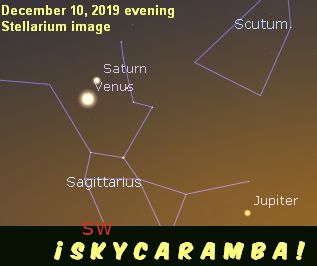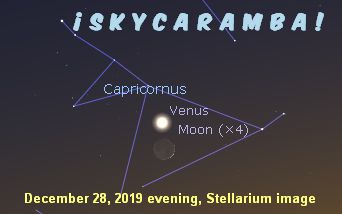
Jupiter, Venus, and Saturn form a nice trio in the evening sky in the first part of December. Look right after sunset. You’ll see Venus first as the twilight fades. It’s between the other two planets on top of the Sagittarius “teapot”. Saturn is on the east side of the teapot and Jupiter on the west. They are nearly holding still while Venus moves noticeably from evening to evening toward Saturn. Around the 10th, Venus and Saturn are close with Jupiter below them.

By the second half of December, Venus has passed Saturn on its way east of Sagittarius. Jupiter is setting right after the sun does and is not seen by northern hemisphere watchers. As Saturn works its way into the sunset in late December, Venus moves deep into Capricornus, one of the dimmer constellations. The moon passes by Venus on the 28th.

Pegasus and Cygnus are high, near the meridian, as the night begins. Taurus and Cetus are rising. Look for Orion, the famous hunter of winter night skies, not much later. Canis Major rises around midnight. Virgo is a morning riser.

Mars and Mercury are somewhat close in the morning as December begins. The red planet is between Virgo and Libra. The messenger planet is in Libra’s diamond. Both planets are moving eastward. Mercury is clearly out of the Libra diamond on the 6th while Mars is heading toward it. See Mars just 0.2° from Zubenelgenubi on the 12th as it enters the diamond. A telescope may reveal to you that Zubenelgenubi is a double star.

The moon passes by Mars on the 22nd and 23rd. By those dates, Mercury has passed the westernmost stars of Scorpius—Acrab, Dschubba, and Fang. You may catch them rising before the morning light begins. They’ll be above and right of the waning crescent moon on the 24th. By the 25th, Mars is exiting the diamond but not passing close to any of the stars that make it. By the end of the month, the red planet and its stellar rival Antares are both visible before sunrise.
The moon is at first quarter on the 4th, full on the 12th, at last quarter on the 19th, and new on the 26th when there’s an annular eclipse of the sun visible from the Arabian peninsula, across southern India, the islands of Maylasia, and just south of the Philippines. Annularity lasts three to three-and-a-half minutes. Partial phases are visible in northeast Africa, southeast Europe, most of Asia, and northern Australia.

Other moon information for the month: apogee is on the 5th with a distance of 404,500 kilometers. Perigee is on the 18th with a distance of 370,300 kilometers. The moon crosses the equator going north on the 6th, reaches northern lunistice on the 13th, goes south of the equator again on the 20th, and is its farthest south on the 26th.

The moon will pass in front of the Gemini star Tejat on the 13th. The occultation is visible from far northeast Asia, Alaska, nearly all of Canada, part of Greenland, and the northern “lower 48” United States.
Mercury is at aphelion on the 30th. Its distance from the sun is 0.467 astronomical units, or 69.9 million kilometers at this time.
The Geminid meteor shower is expected to peak on the 14th.
